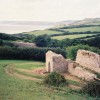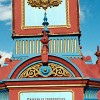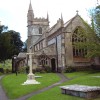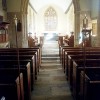Stalbridge, in the Blackmore Vale near to the county boundary with Somerset, is a largish rather ordinary town but it does boast a very fine market cross. The date of which is open to question with some over romantic legends placing it as early as 1309 but the stories don’t fit with historical fact; we prefer to go with the establishment view that is it of the late 15th century. Unlike many similar monuments Stalbridge’s Cross survived the Civil War intact but in the end old-age did for it. During a storm in the winter of 1949-1950 bits of the cross head crumbled away and fell off.The cross head we see today is a restoration.
Carved out of limestone from Marnhull or Todber it stands 30 feet tall. The octagonal base has three steps above a chamfered plinth, the top step supports a square pedestal with moulding capping, the corners having been partially chamfered to give it an octagonal appearance. The tapering shaft is octagonal with pinnacles: each pinnacle has a finial at the top. A corbel from the west face of the shaft supports a carved figure but the weather of centuries makes it unrecognisable today. The shaft is crowned by a capital in the form of four winged figures grasping shields. The modern replica cross head has a canopied recess containing a representation of the crucifixion. Pevsner observes “it must in its day have been a splendidly rich piece.”
The market place was the centre of all town life and the market cross the centre of the market place. John Wesley says in his journal from the 18th century that he preached at Stalbridge Cross and tells us his followers were pelted with mud and filth, though Wesley was unharmed.
From here the Bailiff of the lord of the manor would collect tolls for the live and dead stock, butter, eggs, blue veined cheese and poultry sold at the weekly Tuesday market. The market was held by permission granted to the town in the 12th century by the Abbot of Sherborne. The town used to have two fairs: on April 16th and August 24th and these would have been announced from the market cross, as would news of major national events. The fairs died away and the market struggled on into the 20th century before transferring to Sturminster Newton.
In 1918 Lord Stalbridge sold-off all his interests in the area. The market cross was transferred to the parish council for one-shilling after some minor repairs had been carried out by a local craftsman, Mr Jeans.
The market cross at Stalbridge is one of the finest examples of its type in the country.
We have placed a photograph in the gallery section.



